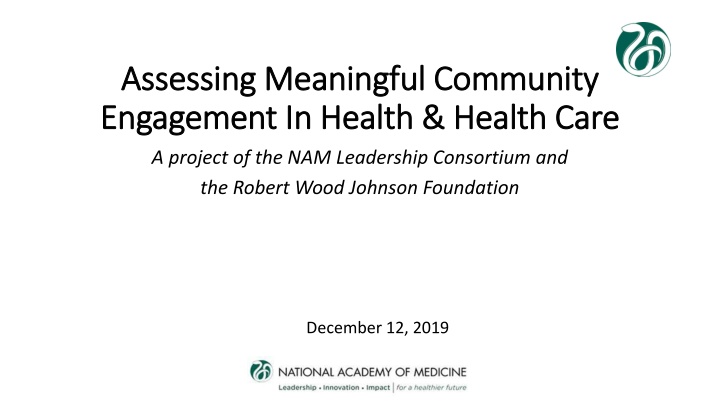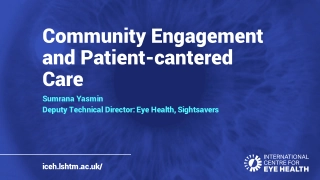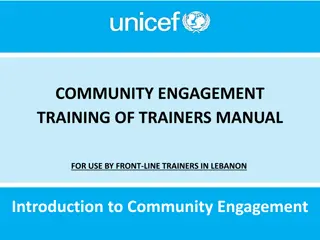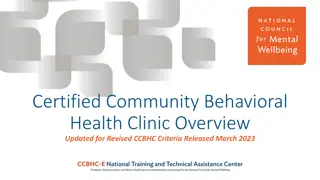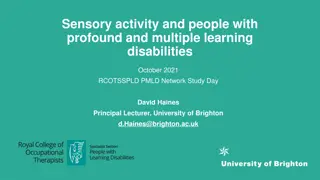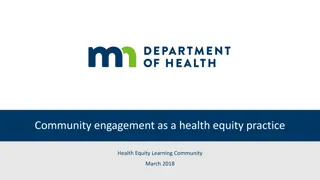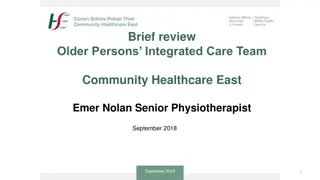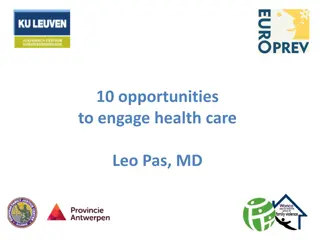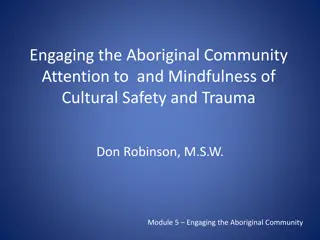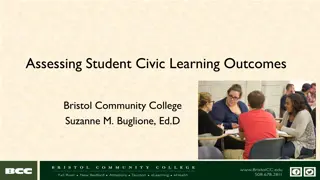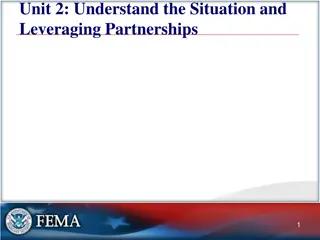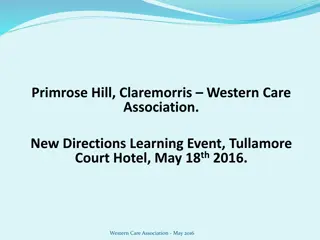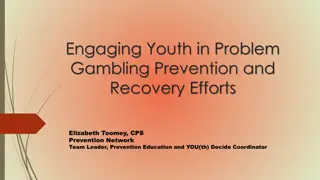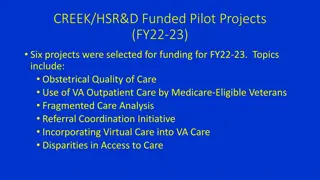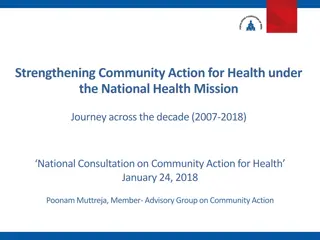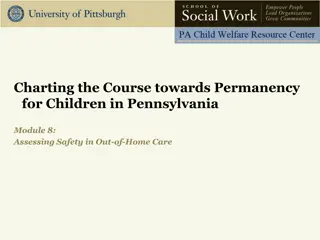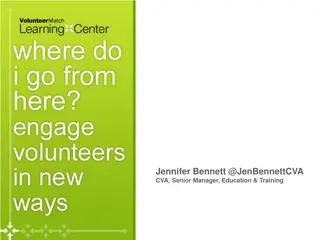Assessing Meaningful Community Engagement in Health & Health Care
This project, led by the NAM Leadership Consortium and the Robert Wood Johnson Foundation, focuses on assessing and advancing the responsiveness of public and private programs to community needs. The goal is to enhance meaningful engagement with diverse audiences in shaping healthcare programs and policies. The steering committee comprises experts from various fields, and the project aims to identify indicators for measuring community engagement and establish a framework for progress.
Download Presentation

Please find below an Image/Link to download the presentation.
The content on the website is provided AS IS for your information and personal use only. It may not be sold, licensed, or shared on other websites without obtaining consent from the author.If you encounter any issues during the download, it is possible that the publisher has removed the file from their server.
You are allowed to download the files provided on this website for personal or commercial use, subject to the condition that they are used lawfully. All files are the property of their respective owners.
The content on the website is provided AS IS for your information and personal use only. It may not be sold, licensed, or shared on other websites without obtaining consent from the author.
E N D
Presentation Transcript
Assessing Meaningful Community Assessing Meaningful Community Engagement In Health & Health Care Engagement In Health & Health Care A project of the NAM Leadership Consortium and the Robert Wood Johnson Foundation December 12, 2019
Background and Goals Background and Goals
Background Background Achieving a culture of health requires meaningful participation of community members as part of the policymaking and program development processes Our aim is to assess and advance the responsiveness of public and private programs to community needs and enhance meaningful engagement with diverse audiences The deliverable will be a NAM Special Publication that identifies candidate measure(s) of meaningful community engagement and establishes a framework for advancement
Steering Committee Members Steering Committee Members Sergio Aguilar-Gaxiola, MD, PhD, University of California, Davis (Co-Chair) Ann Hwang, MD, Community Catalyst (Co-Chair) Syed M. Ahmed, MD, DrPH,Medical College of Wisconsin Karen DeSalvo, MD, University of Texas, Dell Medical School Milton "Mickey" Eder, PhD,University of Minnesota Tekisha Dwan Everette, PhD, MPA,Health Equity Solutions Elmer Freeman, MSW, Center for Community Health Education, Research and Service David Gibbs, Community Initiatives Ella Greene-Moton, Center for Public Health and Community Genomics Sinsi Hern ndez-Cancio, JD, Families USA Dmitry Khodyakov, PhD, RAND Corporation/Pardee Graduate School J. Lloyd Michener, MD, Duke University Bobby Milstein, PhD, MPH, ReThink Health Nina Wallerstein, DrPH, University of New Mexico Jack Westfall, MD, Whole Person Care at Santa Clara Valley Medical Center
Goals of Project Goals of Project Identify an indicator or set of indicators that can be used to measure meaningful community engagement in a wide range of settings that characterize, track, motivate, guide progress on the engagement of individual, family, community groups in shaping how health care programs and policies are developed, implemented, overseen with special emphasis on those most in need
Progress To Date Progress To Date
Defined Community Defined Community Community is a group of individuals organized into a unit or manifesting some unifying trait or common interest. Community need not be defined solely by geography. It can refer to a group that self-identifies by age, ethnicity, gender, sexual orientation faith, life experience, disability, illness, or health condition; it can refer to a common interest or cause, a sense of identification or shared emotional connection, shared values or norms, mutual influence, common interest, or commitment to meeting a shared need. Principles of Community Engagement. Atlanta, Ga: Centers for Disease Control and Prevention, Public Health Practice Program Office; 1997.
Defined (Meaningful) Community Engagement Defined (Meaningful) Community Engagement (Meaningful) Community engagementis the process of working collaboratively with and through groups of people affiliated by geographic proximity or similar situations to address issues affecting the well-being of those people. It is a powerful vehicle for bringing about environmental and behavioral changes that will improve the health of the community and its members. It often involves partnerships and coalitions that help mobilize resources and influence systems, change relationships among partners, and serve as catalysts for changing policies, programs, and practices. Principles of Community Engagement. Atlanta, Ga: Centers for Disease Control and Prevention, Public Health Practice Program Office; 1997.
Determined Audiences and Applications Determined Audiences and Applications Identify audiences and users of measures Federal, state and local agencies, and Tribal communities Advocacy & community-based groups Funders, philanthropy, & financiers Academic institutions Health systems & hospitals Payers, plans, & industry Understand applications and use of measures Evaluate influence of current engagement efforts, activities, and effectiveness Assess financing needs and decisions Evaluate infrastructure and systems change Assess changes in individual and community health and mental health, equity, and well-being
Identified Components of a Conceptual Model Identified Components of a Conceptual Model Develop an easy to understand conceptual model that outlines key components needed to engage communities and measuring the impact of engagement Community Context Principles and Values Drivers of Change Key Outcomes Engagement Approaches and Strategies Relational Outcomes Policy and Program Change Transformational Outcomes
Conducted Literature Search and Conducted Literature Search and Synthesizing Results Synthesizing Results Conducted Literature Search to Identify Relevant Articles Identifying Relevant Selecting Parsimonious List of Measures Measures Searched Embase, Medline, PsycINFO, Pubmed, Scopus Used search terms for engagement, health, outcomes, measurement Identified ~500 high relevant articles Conducting inclusion/ exclusion review at abstract level (~80% complete; ~20% of articles are relevant) Identified relevant reports from grey literature Abstract and synthesize critical information on measures Discuss measures and assess components Qualitative vs quantitative measure Unit of analysis Documented vs. data collection Response burden Validity, reliability, feasibility Identify measures such as Trust development Community participation Capacity Mutual learning Power dynamics Sustainability Collaboration Health outcomes/indicators
Next Steps Next Steps
Timeline Timeline Finalize Case Studies; Map to Conceptual Model (June 2020) Begin to Engage Community Members (Jan 2020) Identify Parsimonious List of Measures (June 2020) Convene 2nd In-person Meeting (April 2020) Finalize Special Publication (Nov. 2020) Develop Complete List of Measures (Feb. 2020) Finalize Conceptual Model (May 2020) Draft Special Publication (June 2020) Finalize Community- Relevant Materials (Nov. 2020) Disseminate Materials (Dec. 2020)
Motivating Questions Motivating Questions What are the most important use cases that should be highlighted in the NAM Special Publication? What additional domains should the measures/measure concepts cover? What criteria should be considered for selecting candidate measures/measure concepts? What considerations should be made to ensure measures are relevant to individuals, families, and communities who are at highest risk? What considerations should be made to identify a parsimonious number of measures that can also be relevant to multiple users?
